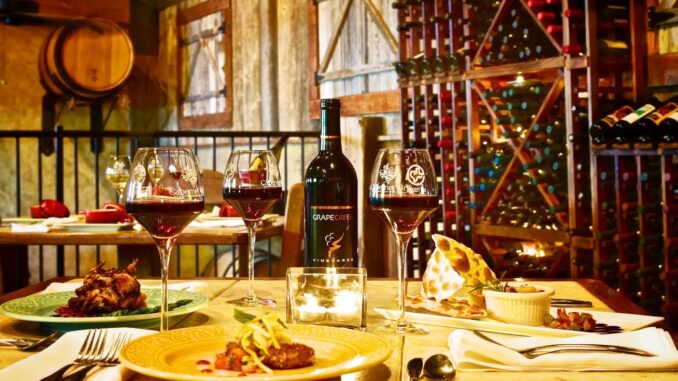
If you have not already enjoyed dinner at Chef Ross Burtwell’s Cabernet Grill Restaurant, it’s something that you really need to get on your calendar for your next visit to Fredericksburg, Texas. It encompasses luscious Texas-inspired cuisine, an all-Texas wine list, rustic ambiance, and gracious service.
Each of Chef Burtwell’s culinary creations features a cacophony of fresh ingredients, titillating aromas and pleasing flavors. Best of all, this Texas-centric cuisine gives you the opportunity to pair your meal with some of Texas’s best wines either guided by your personal tasting experiences or by the Cab Grill’s insightful servers.
Wine Class – Texas Terroir Versus the Classic Rules of Wine and Food Pairing – Back to the Basics
Perhaps to push the dining pleasure still further at his restaurant, Chef Burtwell recently asked me to hold a wine education class with the Cab Grill’s servers and management. I held two midday sessions. In the first, I reviewed a bit of Texas wine history, then what I consider the fundamentals of Texas terroir, and the classic approaches to pairing wine and food (e.g., red wine with meat, white wine with fish and fowl).
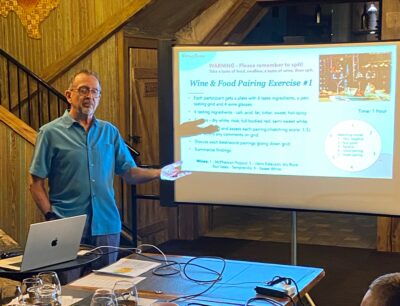
Then, I proceeded to highlight how the classic approaches to wine and food pairing may fall short since these rules are based on the wines that “California taught wine us to drink” and that the other top wine producing states emulated. These wines come by way of Bordeaux and Burgundy; Cabernet, Merlot, Chardonnay and Pinot Noir, the wines I’ve come to call the “California Set”. But, wait a minute, I’ve been quoted before saying, “Texas isn’t Bordeaux and it sure as hell ain’t Burgundy”. The Texas wine lexicon of grape varietals is a bit different.
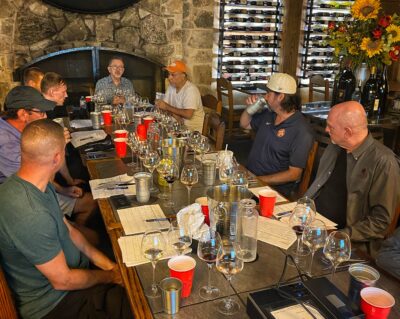
Texas is generally a warmer growing region than those mentioned above and its wines are more like those that come from southern Europe and the Mediterranean. Examples include: Reds – Tempranillo, Mourvèdre, Tannat and Montipulciano; Whites – Viognier, Roussanne, Marsanne, Vermentino, Trebbiano; Award-winning hybrids like Blanc Du Bois and Black Spanish (these wine grapes rather than being European are a blend of European and American DNA were created right here in the old US of A.
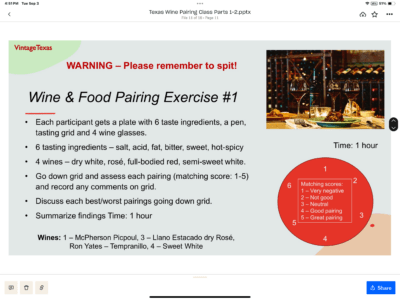
To understand how Texas wines and foods pair, I felt that I needed to rewind and start with the basics. So, I finished this session with a hands-on pairing exercise that illustrated how the major “food groups” in Texas cuisine (i.e. salt, sour, fat, bitter, sweet, and hot/spicy) interact with four basic wine styles (dry white, dry rosé, tannic red, and semi-sweet).
The interesting outcome of this exercise was that the students were surprised to experience first hand that red wines that present natural fruitiness (not to be confused with sweetness), and softer tannins, and wines that actually have a hint of sweetness paired better with salty, bitter, acidic and hot/spicy flavors than did the dry white and tannic red wines. While the tannic reds have a place on the table with charred or roasted hunks of red meat (Yee-Haw!), the rosé and semi-sweet wines in this exercise were most often the most favored pairings especially with respect to the hot/spicy that is featured readily in Texas cuisine.

Different Approaches to Wine and Food Pairing that Work for Texas Wine Drinkers
In the second session, I gave a few suggestions on how servers could non-confrontationally assist diners in the selection of Texas wines to go with their Cab Grill meals. One interesting approach that I learned at a session at the Aspen Food & Wine Festival several years ago is what I call “Wine Selection By Osmosis” that comes by talking to customers about their preference in other beverages, e.g., tea, coffee or soft drinks. Here is an example of this approach:
- Black coffee drinkers are more likely to prefer bolder or more tannic wines.
If they drink coffee with milk and sugar, they may prefer softer, fruitier wines. - If they prefer sodas or sweet tea, they may also prefer an off-dry or even sweet wine.
- Tea drinkers are similar and if they say, strong “black tea” think black coffee (and go to the 1st bullet above). But, if they say, “Tea with lemon” or I drink “lemon aid” this might be a lead-in to selecting crisp and citrusy white wines.
It doesn’t always work, but it does make for good non-stressful, table-side conversation.
I also presented my “15 Point Cheat Sheet” for Texas wine and food pairing. It is based on the classic pairings that are typically found in the major wine publications like Food & Wine or Wine Spectator. But, my Texas “cheat sheet”suggests wines made from other grape varieties that may not be part of the “California Set”, but do particularly well in our state’s sunny, warm weather. A few examples are:
- Classic Pairing: Pinot Noir when they are looking for a wine with medium body and soft earthiness. Suggest – Texas Sangiovese, Mourvèdre or Counoise.
- Classic Pairing: Champagne with anything festive, salty or fun. Suggest – Texas Sparkling Blanc Du Bois, Trebbiano, Roussanne.
- Classic Pairing: Malbec with sweet juicy BBQ sauces. Suggest – Texas fruity reds that include Malbec, and others like Petite Sirah, GSM’s or Merlot, or even sweet rosés or reds.
- Classic Pairing: Chardonnay with fatty fish or fish with rich creamy or buttery sauces. Suggest – Texas Roussanne or Viognier (with oak if available).
There are eleven more of my suggested Texas wine and food pairings (Soon to be classics themselves) that are on my “cheat sheet”.
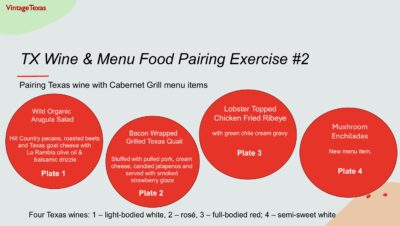
We finished the second session with another hands-on exercise, but this one paired the same four wines (dry white, dry rosé, tannic red, and semi-sweet) with actual menu items from Cabernet Grill. This put the students knowledge gained from the first session to practical use.
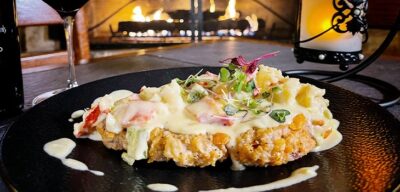
See a summary below:
Plate 1 – Wild Organic Arugula Salad – Hill Country pecans, roasted beets and Texas goat cheese with La Rambla olive oil & balsamic drizzle:
Salads are typically a hard wine pairing. But, in this case, the salad itself presented a bit of sweetness to counter the tartness of vinegar and hard flavor of the Arugula. The two wines the student picked most often were the dry white and the rosé wine; I assume that his would not have been the case if there was not sweetness in the salad.
Plate 2 – Bacon Wrapped Grilled Texas Quail – Stuffed with pulled pork, cream cheese, candied jalapeños and served with smoked strawberry glaze:
This dish had a depth of flavors of herbed and smoked meat served with a bite of spicy/hot and sweetness. The students were evenly split three ways among the dry rosé, red wines and the semi-sweet wine and all were good choices justified by their personal preferences. I asked if those that selected the tannic red wine were black coffee drinkers. And, you know what, they were. Chalk one up for the other beverage method of selecting wines.
Plate 3 – Lobster Topped Chicken Fried Ribeye – with green chile cream gravy:
This is one of my favorite dishes served at the Cab Grill, but “turf and surf” items like this are notoriously hard to pair with wine. In this case, the students leaned more toward the red wine, but some like me, selected the white wine or rosé as the best pairing. After this wine food pairing, I realized why all of these wines (white to rosé to red) “worked” with Chef Burtwell’s Texas “turf and surf” preparation. It was the magic of the white sauce. Burtwell’s green chile cream gravy was the “melding agent” that allowed this dish of shellfish and beef to go either directions. The “chicken fried” batter coating on the steak likely helped, too.
Plate 4 – Lions Mane Mushroom Roasted Enchiladas with “Awesome Beans”, pickled spanish onions and local goat cheese (new Cab Grill menu item):
This dish really had an interesting breadth of flavors in play, but there wasn’t any one flavor element that dominated the dinning experience. It was the melding of the mushroom, beans (with a hint of curry), onions and goat cheese (all distinctively discernible flavors) that called for a wine that would not overwhelm or be disrupt the dish. A few students selected the red wine as the most fitting pairing, but most others liked the dry rosé or the semi-sweet wines. In my mind’s eye (or palate), I have always defaulted to a softer, fruity red wine like Merlot to pair with earthy mushroom dishes, but other Texas red wines that could also “fill the bill” could be Montepulciano, Petite Sirah or a GSM.
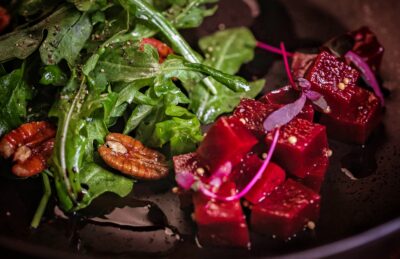
Conclusions – The Final Analysis
All-in-all, it was an interesting class, one in which it was obvious the students found a new and perhaps deeper understanding of wine and food pairing. I know that Chef Burtwell would like to invite you to stop in for dinner at his Cabernet Grill restaurant and put either your experience or his servers newly gained knowledge to the test of Texas wine selection during a delightful Texas dining experience. But, no worries, his great menu and all-Texas wine list gives you many options to explore. Also, if you can’t decide on one wine, the restaurant serves three wine flight each containing three wines. This way you can do your own “experiment” to help you find your favorites.
Enjoy,
Russ Kane, aka Doc Russ, Texas Wineslinger
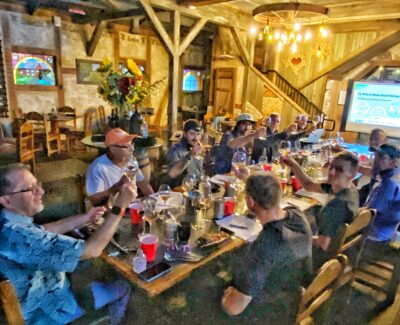



Be the first to comment